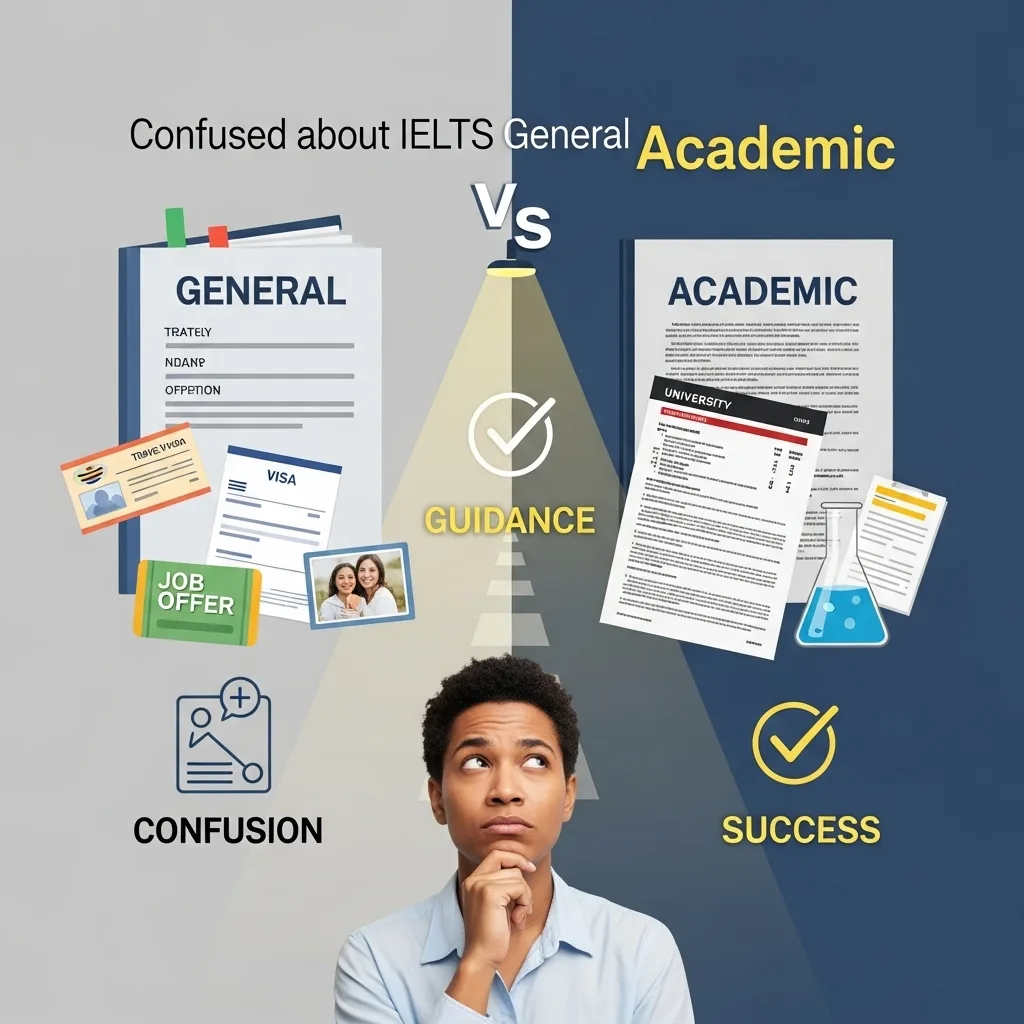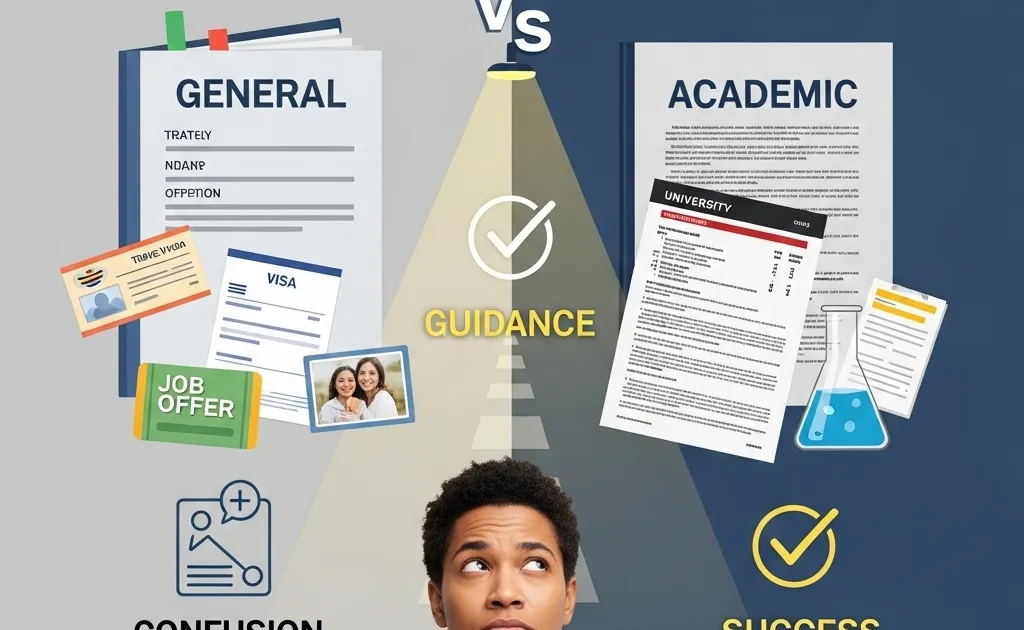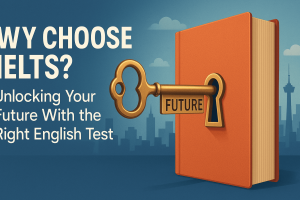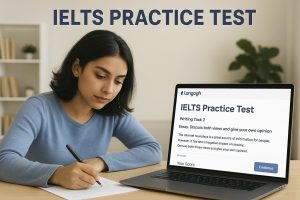Choosing between IELTS General Training and IELTS Academic can feel like standing at a crossroads. Take the wrong path, and you might end up retaking the test (and spending another $250+). But here’s the good news: understanding the differences between these two tests is simpler than you think.
Whether you’re planning to study abroad, immigrate to an English-speaking country, or pursue professional registration, this guide will help you make the right choice—and prepare effectively.
What is IELTS? A Quick Refresher
The International English Language Testing System (IELTS) is the world’s most popular English proficiency test, accepted by over 11,000 organizations worldwide. But unlike most standardized tests, IELTS comes in two flavors: Academic and General Training.
Both tests assess your English skills across four areas:
- Listening (30 minutes)
- Reading (60 minutes)
- Writing (60 minutes)
- Speaking (11-14 minutes)
The total test time is just under 3 hours, and you’ll receive a band score from 1 to 9 for each section, plus an overall band score.
The Key Difference: Purpose and Context
Here’s the bottom line: IELTS Academic tests your English in an educational setting, while IELTS General Training assesses your English for everyday life and work environments.
Think of it this way: If Academic IELTS were a movie, it would be set in university lecture halls and research libraries. General Training IELTS? That’s more like a workplace drama with scenes at the immigration office.
When to Take IELTS Academic
Choose IELTS Academic if you’re:
- Applying for undergraduate or postgraduate programs
- Seeking professional registration in an English-speaking country (medicine, nursing, engineering)
- Looking for student visas in the UK, Australia, Canada, or New Zealand
Example: Sarah wants to pursue her Master’s in Computer Science at the University of Toronto. She needs IELTS Academic because universities require proof that she can understand complex academic texts and write research-style essays.
When to Take IELTS General Training
Choose IELTS General Training if you’re:
- Applying for immigration (Canada, Australia, New Zealand, UK)
- Seeking work experience or training programs
- Planning secondary education (high school level)
- Meeting visa requirements for non-academic purposes
Example: Michael is applying for permanent residency in Canada through Express Entry. He needs IELTS General Training to demonstrate he can handle everyday situations—reading workplace emails, writing personal letters, and understanding community notices.
Section-by-Section Breakdown
Listening: Identical for Both Tests
Good news! The Listening section is exactly the same for both Academic and General Training. You’ll hear four recordings featuring native English speakers and answer 40 questions. This includes:
- A conversation in an everyday social context
- A monologue in an everyday context
- A conversation in an educational or training context
- A monologue on an academic subject
No difference here—you can use the same preparation materials for both tests.
Reading: Where Things Get Different
This is where the two tests diverge significantly.
IELTS Academic Reading
You’ll face three long passages (about 2,150-2,750 words total) from:
- Books and journals
- Newspapers and magazines
- Academic sources
The texts are complex and include graphs, diagrams, and illustrations.
Example question: You might read a 900-word passage about “The Evolution of Urban Planning” and answer questions about the writer’s arguments, identify specific information, or match headings to paragraphs.
IELTS General Training Reading
The test has three sections with increasing difficulty:
- Section 1: Two or three short factual texts (notices, advertisements, timetables)
- Section 2: Two short work-related texts (job descriptions, contracts, training materials)
- Section 3: One longer, more complex general interest text
Example: Section 1 might give you a gym membership brochure asking you to identify what’s included in the premium package. Section 3 could be an article about “Remote Work Trends” similar to what you’d find in a magazine.
The language in General Training is generally more accessible, but don’t underestimate it—the time pressure is real!

Writing: Different Tasks, Different Goals
IELTS Academic Writing
Task 1 (20 minutes): Describe visual information—graphs, charts, tables, diagrams, or maps. You need to write at least 150 words summarizing and explaining the data.
Example: “The line graph shows the percentage of households with internet access in five European countries between 2010 and 2020.”
Task 2 (40 minutes): Write an essay (at least 250 words) responding to an argument or problem. This requires formal academic writing.
Example topic: “Some people believe that universities should only offer courses that are useful for future careers. Others think universities should provide knowledge for its own sake. Discuss both views and give your opinion.”
IELTS General Training Writing
Task 1 (20 minutes): Write a letter (at least 150 words). It could be personal, semi-formal, or formal.
Example: “You recently bought a product online, but it arrived damaged. Write a letter to the customer service department explaining the problem, how it happened, and what you want them to do about it.”
Task 2 (40 minutes): Write an essay (at least 250 words) responding to a point of view or argument. The style is less formal than Academic, and topics are more general.
Example topic: “Many people prefer to work from home rather than commute to an office. What are the advantages and disadvantages of this trend?”
Speaking: Identical for Both Tests
Just like Listening, the Speaking test is the same for both versions. You’ll have a face-to-face conversation with an examiner covering:
- Part 1: Introduction and general questions (4-5 minutes)
- Part 2: Individual long turn with a topic card (3-4 minutes)
- Part 3: Two-way discussion on abstract ideas (4-5 minutes)
Scoring: Same Band System, Different Challenges
Both tests use the same 9-band scoring system, but here’s an important insight: Getting a Band 7 in Academic Reading is not the same as getting a Band 7 in General Training Reading.
Academic texts are more complex, so you might answer fewer questions correctly and still achieve the same band score as someone who answered more questions correctly in General Training.
Many immigration programs require specific band scores. For Canadian immigration, for example, a CLB 9 (roughly IELTS Band 7) can significantly boost your Comprehensive Ranking System score.
Common Mistakes Test-Takers Make
Mistake #1: Taking the Wrong Test
This happens more often than you’d think! Some students take Academic when they only need General Training for immigration, making the test unnecessarily difficult.
Solution: Confirm requirements with your university, immigration office, or professional body before booking.
Mistake #2: Assuming General Training is “Easy”
General Training isn’t easier—it’s different. The Reading section may seem more straightforward, but the time constraints are equally challenging, and Task 1 Writing requires specific letter-writing skills many test-takers haven’t practiced.
Mistake #3: Using the Wrong Preparation Materials
If you’re taking General Training but practicing with Academic materials (or vice versa), you’re wasting valuable study time.
How Langogh Helps You Prepare for IELTS Success
Preparing for IELTS—whether Academic or General Training—requires the right strategy, practice materials, and feedback. That’s where Langogh comes in.
Tailored Preparation for Your Test Type
Langogh offers separate preparation tracks for IELTS Academic and General Training, ensuring you practice exactly what you’ll see on test day. No more wondering if you’re using the right materials—we’ve got you covered.
Comprehensive Practice Tests
Get access to full-length mock tests that simulate real IELTS conditions:
- Timed practice for all four sections
- Authentic question types
- Detailed answer explanations
- Band score predictions to track your progress
Example: If you’re preparing for General Training, you’ll practice reading authentic workplace emails and community notices—not academic journals you’ll never encounter on your test.
AI-Powered Writing Feedback
Writing is often the most challenging section for test-takers. Langogh provides:
- Instant feedback on your essays and letters
- Specific suggestions for improvement
- Band score estimates for each criterion (Task Achievement, Coherence, Vocabulary, Grammar)
- Sample answers at different band levels
Imagine submitting your Task 1 letter about a damaged product and receiving detailed feedback within minutes—highlighting exactly where you can improve your tone, organization, and language.
Speaking Practice with Confidence
Our platform includes:
- Speaking prompts for all three parts of the test
- Recording features to review your responses
- Model answers from high-scoring test-takers
- Tips for improving fluency and pronunciation
Personalized Study Plans
Not sure where to start? Langogh creates customized study plans based on:
- Your target band score
- Your current English level
- Your test date
- Your strengths and weaknesses
If you’re stronger in Reading but struggling with Writing, your plan will allocate more practice time accordingly.
Expert Strategies and Tips
Learn proven strategies from IELTS experts:
- Time management techniques
- How to identify question types quickly
- Paraphrasing skills for Reading and Listening
- Vocabulary building for higher band scores
Flexible Learning for Busy Lives
Whether you’re a working professional or a full-time student, Langogh fits into your schedule:
- Study anytime, anywhere on your device
- Short, focused lessons for busy days
- Intensive practice sessions when you have more time
- Progress tracking to stay motivated
Your IELTS Success Roadmap
Step 1: Identify Your Test Type
Confirm whether you need Academic or General Training based on your goals.
Step 2: Set Your Target Score
Research the band score requirements for your specific purpose (university admission, immigration points, professional registration).
Step 3: Take a Diagnostic Test
Assess your current level to understand where you stand and what you need to improve.
Step 4: Create a Study Plan
Allocate time for each section based on your strengths and weaknesses. Most test-takers need 4-12 weeks of preparation.
Step 5: Practice Consistently
Regular practice is more effective than cramming. Even 30 minutes daily can make a significant difference.
Step 6: Get Feedback
Use Langogh’s AI-powered tools to receive detailed feedback on your Writing and Speaking performance.
Step 7: Take Full Practice Tests
Simulate test conditions with timed practice tests at least 2-3 times before your actual exam.
Final Thoughts: Your Success Starts with the Right Choice
Choosing between IELTS Academic and General Training isn’t about which test is easier—it’s about which test aligns with your goals. Academic opens doors to universities and academic careers. General Training paves the way for immigration and workplace opportunities.
Whichever path you choose, remember: IELTS success isn’t about being a native English speaker. It’s about understanding the test format, practicing strategically, and developing the specific skills each section demands.
With Langogh’s comprehensive platform, you’re not just preparing for a test—you’re building lasting English skills that will serve you in your academic journey, career, or new life abroad.
Ready to start your IELTS preparation journey? Visit Langogh today and discover how our tailored approach can help you achieve your target band score with confidence.
Your future is waiting—let’s make sure you’re ready for it: Sign up here




